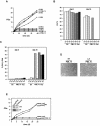Human papillomavirus oncoprotein E7 targets the promyelocytic leukemia protein and circumvents cellular senescence via the Rb and p53 tumor suppressor pathways
- PMID: 15657429
- PMCID: PMC543993
- DOI: 10.1128/MCB.25.3.1013-1024.2005
Human papillomavirus oncoprotein E7 targets the promyelocytic leukemia protein and circumvents cellular senescence via the Rb and p53 tumor suppressor pathways
Retraction in
-
Retraction for Bischof et al., "Human Papillomavirus Oncoprotein E7 Targets the Promyelocytic Leukemia Protein and Circumvents Cellular Senescence via the Rb and p53 Tumor Suppressor Pathways".Mol Cell Biol. 2020 Oct 26;40(22):e00482-20. doi: 10.1128/MCB.00482-20. Print 2020 Oct 26. Mol Cell Biol. 2020. PMID: 33106371 Free PMC article. No abstract available.
Abstract
Cellular senescence can be triggered by a variety of signals, including loss of telomeric integrity or intense oncogenic signaling, and is considered a potent, natural tumor suppressor mechanism. Previously, it was shown that the promyelocytic leukemia protein (PML) induces cellular senescence when overexpressed in primary human fibroblasts. The mechanism by which the PML IV isoform elicits this irreversible growth arrest is believed to involve activation of the tumor suppressor pathways p21/p53 and p16/Rb; however, a requirement for either pathway has not been demonstrated unequivocally. To investigate the individual contributions of p53 and Rb to PML-induced senescence, we used oncoproteins E6 and E7 from human papillomaviruses (HPVs), which predominantly target p53 and Rb. We show that E7, but not E6, circumvents PML-induced senescence. Using different E7 mutant proteins, dominant negative cyclin-dependent kinase 4, and p16 RNA interference, we demonstrate that Rb-related and Rb-independent mechanisms of E7 are necessary for subversion of PML-induced senescence and we identify PML as a novel target for E7. Interaction between E7 and a functional prosenescence complex composed of PML, p53, and CBP perturbs transcriptional activation of p53, thus highlighting a significant effect also on the p53 tumor suppressor pathway. Given the importance of HPV in the pathogenesis of cervical cancer, our results warrant a more detailed analyses of PML in HPV infections.
Figures






Similar articles
-
Human fibroblasts require the Rb family of tumor suppressors, but not p53, for PML-induced senescence.Oncogene. 2004 Jan 8;23(1):91-9. doi: 10.1038/sj.onc.1206886. Oncogene. 2004. PMID: 14712214
-
E2FBP1 antagonizes the p16(INK4A)-Rb tumor suppressor machinery for growth suppression and cellular senescence by regulating promyelocytic leukemia protein stability.Int J Oral Sci. 2011 Oct;3(4):200-8. doi: 10.4248/IJOS11071. Int J Oral Sci. 2011. PMID: 22010578 Free PMC article.
-
Repression of human papillomavirus oncogenes in HeLa cervical carcinoma cells causes the orderly reactivation of dormant tumor suppressor pathways.Proc Natl Acad Sci U S A. 2000 Nov 7;97(23):12513-8. doi: 10.1073/pnas.97.23.12513. Proc Natl Acad Sci U S A. 2000. PMID: 11070078 Free PMC article.
-
PML links aberrant cytokine signaling and oncogenic stress to cellular senescence.Front Biosci (Landmark Ed). 2009 Jan 1;14(2):475-85. doi: 10.2741/3256. Front Biosci (Landmark Ed). 2009. PMID: 19273079 Review.
-
Interactions of human papillomavirus transforming proteins with the products of tumor suppressor genes.FASEB J. 1993 Jul;7(10):872-9. doi: 10.1096/fasebj.7.10.8393818. FASEB J. 1993. PMID: 8393818 Review.
Cited by
-
LncRNA MALAT1 was regulated by HPV16 E7 independently of pRB in cervical cancer cells.J Cancer. 2021 Aug 28;12(21):6344-6355. doi: 10.7150/jca.61194. eCollection 2021. J Cancer. 2021. PMID: 34659524 Free PMC article.
-
Repression of the SUMO-specific protease Senp1 induces p53-dependent premature senescence in normal human fibroblasts.Aging Cell. 2008 Oct;7(5):609-21. doi: 10.1111/j.1474-9726.2008.00411.x. Epub 2008 Jul 24. Aging Cell. 2008. PMID: 18616636 Free PMC article.
-
Promyelocytic leukemia-nuclear body proteins: herpesvirus enemies, accomplices, or both?Future Virol. 2008 May 1;3(3):265-277. doi: 10.2217/17460794.3.3.265. Future Virol. 2008. PMID: 19763230 Free PMC article.
-
Cellular senescence and its effector programs.Genes Dev. 2014 Jan 15;28(2):99-114. doi: 10.1101/gad.235184.113. Genes Dev. 2014. PMID: 24449267 Free PMC article. Review.
-
Human papillomavirus 18 E6 inhibits phosphorylation of p53 expressed in HeLa cells.Cell Biosci. 2012 Jan 13;2:2. doi: 10.1186/2045-3701-2-2. Cell Biosci. 2012. PMID: 22244155 Free PMC article.
References
-
- Appella, E., and C. W. Anderson. 2001. Post-translational modifications and activation of p53 by genotoxic stresses. Eur. J. Biochem. 268:2764-2772. - PubMed
-
- Avvakumov, N., J. Torchia, and J. S. Mymryk. 2003. Interaction of the HPV E7 proteins with the pCAF acetyltransferase. Oncogene 22:3833-3841. - PubMed
-
- Bartkova, J., J. Lukas, H. Muller, M. Strauss, B. Gusterson, and J. Bartek. 1995. Abnormal patterns of D-type cyclin expression and G1 regulation in human head and neck cancer. Cancer Res. 55:949-956. - PubMed
-
- Bernat, A., N. Avvakumov, J. S. Mymryk, and L. Banks. 2003. Interaction between the HPV E7 oncoprotein and the transcriptional coactivator p300. Oncogene 22:7871-7881. - PubMed
Publication types
MeSH terms
Substances
LinkOut - more resources
Full Text Sources
Research Materials
Miscellaneous
